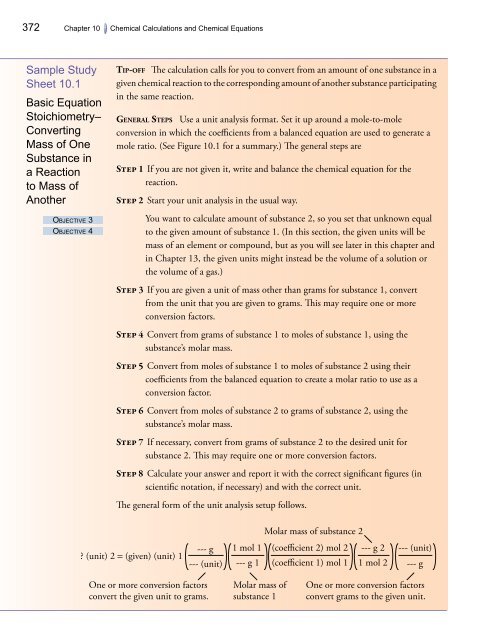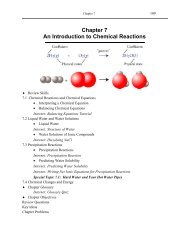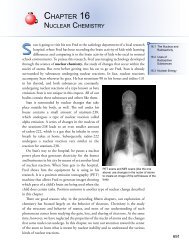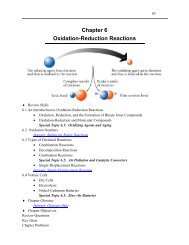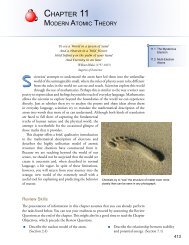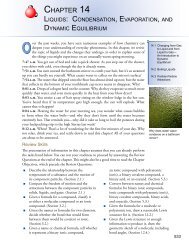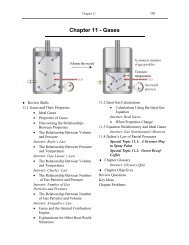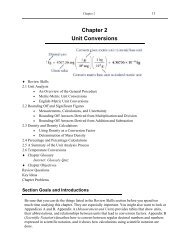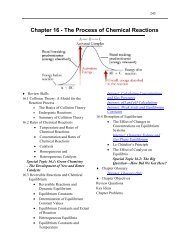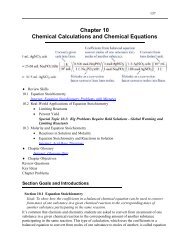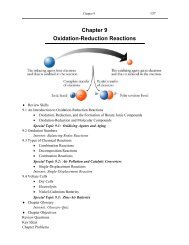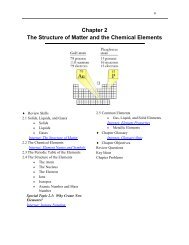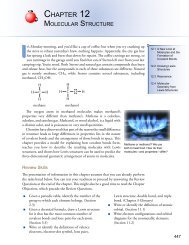Chapter 10 - An Introduction to Chemistry: Chemical Calculations ...
Chapter 10 - An Introduction to Chemistry: Chemical Calculations ...
Chapter 10 - An Introduction to Chemistry: Chemical Calculations ...
You also want an ePaper? Increase the reach of your titles
YUMPU automatically turns print PDFs into web optimized ePapers that Google loves.
372 <strong>Chapter</strong> <strong>10</strong> <strong>Chemical</strong> <strong>Calculations</strong> and <strong>Chemical</strong> Equations<br />
Sample Study<br />
Sheet <strong>10</strong>.1<br />
Basic Equation<br />
S<strong>to</strong>ichiometry–<br />
Converting<br />
Mass of One<br />
Substance in<br />
a Reaction<br />
<strong>to</strong> Mass of<br />
<strong>An</strong>other<br />
Objective 3<br />
Objective 4<br />
Tip-off The calculation calls for you <strong>to</strong> convert from an amount of one substance in a<br />
given chemical reaction <strong>to</strong> the corresponding amount of another substance participating<br />
in the same reaction.<br />
General Steps Use a unit analysis format. Set it up around a mole‐<strong>to</strong>‐mole<br />
conversion in which the coefficients from a balanced equation are used <strong>to</strong> generate a<br />
mole ratio. (See Figure <strong>10</strong>.1 for a summary.) The general steps are<br />
Step 1 If you are not given it, write and balance the chemical equation for the<br />
reaction.<br />
Step 2 Start your unit analysis in the usual way.<br />
You want <strong>to</strong> calculate amount of substance 2, so you set that unknown equal<br />
<strong>to</strong> the given amount of substance 1. (In this section, the given units will be<br />
mass of an element or compound, but as you will see later in this chapter and<br />
in <strong>Chapter</strong> 13, the given units might instead be the volume of a solution or<br />
the volume of a gas.)<br />
Step 3 If you are given a unit of mass other than grams for substance 1, convert<br />
from the unit that you are given <strong>to</strong> grams. This may require one or more<br />
conversion fac<strong>to</strong>rs.<br />
Step 4 Convert from grams of substance 1 <strong>to</strong> moles of substance 1, using the<br />
substance’s molar mass.<br />
Step 5 Convert from moles of substance 1 <strong>to</strong> moles of substance 2 using their<br />
coefficients from the balanced equation <strong>to</strong> create a molar ratio <strong>to</strong> use as a<br />
conversion fac<strong>to</strong>r.<br />
Step 6 Convert from moles of substance 2 <strong>to</strong> grams of substance 2, using the<br />
substance’s molar mass.<br />
Step 7 If necessary, convert from grams of substance 2 <strong>to</strong> the desired unit for<br />
substance 2. This may require one or more conversion fac<strong>to</strong>rs.<br />
Step 8 Calculate your answer and report it with the correct significant figures (in<br />
scientific notation, if necessary) and with the correct unit.<br />
The general form of the unit analysis setup follows.<br />
Molar mass of substance 2<br />
? (unit) 2 = (given) (unit) 1<br />
--- g<br />
--- (unit)<br />
1 mol 1 (coefficient 2) mol 2 --- g 2<br />
--- g 1 (coefficient 1) mol 1 1 mol 2<br />
--- (unit)<br />
--- g<br />
One or more conversion fac<strong>to</strong>rs<br />
convert the given unit <strong>to</strong> grams.<br />
Molar mass of<br />
substance 1<br />
One or more conversion fac<strong>to</strong>rs<br />
convert grams <strong>to</strong> the given unit.


